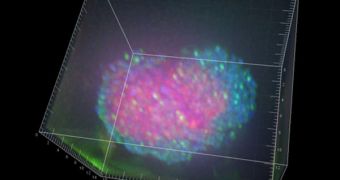Scientists at the California Institute of Technology (Caltech) recently made a discovery that may open up the way of studying the planet's elusive nitrogen cycle. While the paths other chemicals, such as carbon, take are relatively well known, nitrogen is still a bit of a mystery in the way it takes to circle through the Earth's atmosphere, oceans and ground. The key, the experts write in the latest issue of the journal Science, may lay with an unexpected metabolic ability that the symbiotic community of deep-sea microorganisms has, the US National Science Foundation (NSF) reports.
Nitrogen is one of the main components of amino-acids, the building blocks of proteins. The latter are structures without which life as we know would not be possible. The chemical also makes up about 78 percent of the planet's atmosphere, the largest percentage of a single element. The thing about it is that nitrogen can usually be found in a form in which it is strongly bounded to itself. In order to become useful, it first has to be extracted from this coupling, which allows it to take on one extra electron, and thus become chemically reactive.
Bacteria are the main carriers in this conversion process, transforming more nitrogen in a fixed state than lightning, combustion, and other non-biological processes. Photosynthetic aquatic cyanobacteria are the most effective of the microorganisms, producing the largest percentage of nitrogen in the world's waters. In spite of this knowledge, researchers have noticed that, when comparing the amount of nitrogen created from all biological and non-biological sources with the amounts soaked up by the land and sea, they have come up short. This means that some quantities are lost on the way somewhere.
For a long time, the scientific community has been puzzled at how nitrogen seems to be consumed in much larger quantities than it's produced in. It has concluded that the chemical's cycle is out of balance, but could not provide an explanation for this. Now, Caltech geobiologist Victoria Orphan, together with colleagues Rachel Poretsky, a postdoctoral researcher, and Anne Dekas, a graduate student, believe that an incomplete catalogue of the sources of fixed nitrogen may be the reason for the disparity.
“The past discovery that archaeal/bacterial consortia were the agents of methane oxidation led to a paradigm shift in our view of carbon cycling at the bottom of the ocean. This new finding extends that paradigm shift to the nitrogen cycle. Such discoveries are revolutionizing how we think about microbial physiological ecology and its impact on Earth's biogeochemical cycles,” NSF Division of Environmental Biology (DEB) Program Director Matt Kane says. The DEB and the NSF Division of Ocean Sciences funded the new research.

 14 DAY TRIAL //
14 DAY TRIAL //